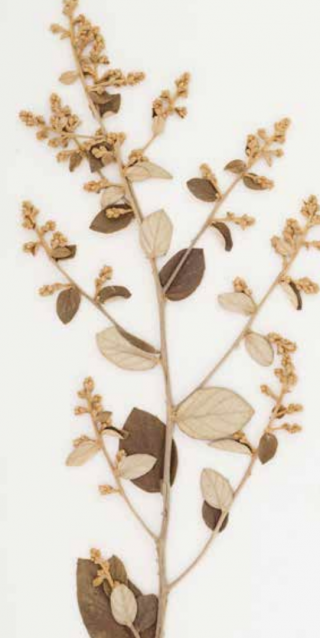Pressed for Time: Herbaria & Environmental Threats Assessment
Posted in Garden News on November 20, 2019 by Barbara Thiers
Barbara M. Thiers, Ph.D., is the Vice President and Patricia K. Holmgren Director of the William and Lynda Steere Herbarium, and Curator of Bryophytes at The New York Botanical Garden.
 Herbarium specimens are one of the very few tangible sources of information about how plants and fungi lived before industrialization, and during each successive period of technological advance since then. Through creative adaptation of technologies developed to address other questions, researchers today can glean information from herbarium specimens about an organism’s physiology, its reproduction, interaction with pollinators, predators and parasites, and the atmosphere around it, for example, the presence of pollutants in the soil and the chemical composition of the air.
Herbarium specimens are one of the very few tangible sources of information about how plants and fungi lived before industrialization, and during each successive period of technological advance since then. Through creative adaptation of technologies developed to address other questions, researchers today can glean information from herbarium specimens about an organism’s physiology, its reproduction, interaction with pollinators, predators and parasites, and the atmosphere around it, for example, the presence of pollutants in the soil and the chemical composition of the air.
Plants have small openings on the undersides of their leaves called stomates that allow Carbon Dioxide (CO2) to enter the leaf for the process of photosynthesis, and allow Oxygen (O2), a byproduct of photosynthesis, to enter to air. A variety of studies have demonstrated that leaves produce fewer of these stomates when CO2 concentrations in the air rise. Examination of stomates on herbarium specimens confirm other evidence that CO2 levels are rising, and help to correlate this rise with other types of climatic and human-mediated events. Assays of plant tissue from herbarium specimens can also help find previously unidentified sources of pollution. Herbarium specimens have been used to track historical levels of radiation and heavy metals to serve as a baseline for pre-pollution conditions, and to assess the reaction of a species to the presence of these compounds. These techniques were used to study long-term effects of known pollutions events, such as the Chernobyl nuclear disaster, or can be used to discover previously unknown contamination events.
Herbarium specimens are also used to study changes in phenology, that is, the timing of the plant life cycle, including leaf out, flowering and fruiting times. Herbarium specimen studies are providing strong evidence that with global warming, the plant life cycle is being accelerated. One of the main concerns about phenological changes is the possibility of a mismatch between plants and other organisms with which plants are interdependent, for example bees, which are of course critical for pollination of key crops.
The study of individual species collected at different times may allow us to compare the recent population size fluctuation between endangered and low-concern species, or track colonization routes of invasive species. Herbaria can be used to help determine when historical invasions took place and how they spread. Specimens in the William and Lynda Steere Herbarium have been used in at least two major invasive species studies: the development of invasiveness in cheat grass, which costs about 1 billion dollars per year in lost agricultural revenue in the western U.S., and in the starry stonewort (the alga Nitellopsis obtusa), which is impacting fishing and recreation in lakes in central and eastern North America. Understanding how these organisms become invasive is key to understanding how to manage them, and also how to develop early warning systems for new potential invaders.
Finally, herbarium specimens are an excellent source of DNA that, using the most advanced techniques, helps us understand the genetic basis of key traits that help plants adapt to particular habitats, with the idea that once these genes are identified, they can be introduced into crop plants through breeding programs to make our key food sources more resilient. A major project that surveyed more than 10,000 specimens from our herbarium during the past year is looking at the evolution of nitrogen fixation in plants, which, if this gene could be introduced in to crops that currently lack it, could reduce fertilizer use and produce more successful crops at a lower cost and using less water.
This article originally appeared as part of the Fall 2019-Winter 2020 issue of Garden News, NYBG’s seasonal newsletter. For further reading, view the issue online and discover a sampling of stories about current programs and undertaking at the Garden.

